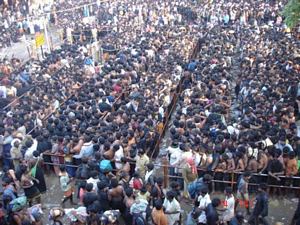Sabarimala is a renowned Hindu temple in Kerala which attracts millions of pilgrims annually during the two months starting from mid-November to mid-January. Most of them are from the four southern states, and the majority among them from Tamil Nadu and Andhra Pradesh, where it is said that preparations for the annual journey runs all the year round. People often take pride in counting the number of times they have set foot on the holy hills. Being a rich, but quaint little temple tucked away in the middle of lush green rainforest, the pilgrimage is doubly attractive on the sightseeing and adventurous potential too, with chance encounters with wild animals. At least, that was the way things were until a few decades ago. Now the forest pathways are choked with the huge numbers of pilgrims and the infrastructural facilities are woefully inadequate. Some times, it takes 20 hours to have ‘darshan’ (sighting of the idol for offering prayers) which you have to spend in long queues often in blistering heat.
Sabarimala is marketed in a quite unique way by the Kerala Government which owns the temple. On the Makara Sankranti day (mid-January, this time on Jan 14th), hundreds of thousands of devotees flock to the hills to witness the ‘supernatural’ phenomenon occurring regularly on the dark, steep hills opposite to the shrine. Every year, when evening poojas are consecrated in the temple on Sankranti day, a beam of mysterious light will appear thrice, each time for a very brief interval. The frenzy of the pilgrims upon seeing this out-of-the-world experience is ming boggling. The hills would vibrate with chants of the sea of humanity uttered in unison for praising the deity.
This time, things were a little more serious. In the stampede which followed the appearance of the divine ‘jyoti’ (light) at Pullumedu, 103 people were brutally killed, most of them with grievous damage to internal organs in the melee. Hundreds were injured and at the time of writing this, search is still on for the tens of people missing. Stampedes are nothing strange at Sabarimala as 53 people were killed in another jyoti stampede in 1999 at Pampa base camp. As happened then, this time also, almost all of the deceased were from Tamil Nadu and Andhra Pradesh. So, what prompts these people to walk to their deaths in an isolated place far away from their homes? The appeal of the supernatural is a potent one, capable of upsetting the mental balance of the gullible. Isn’t it worthwhile to lay down one’s life on the altar of the ‘all-powerful’ god, while witnessing one of his wonders in this miracle-hungry world?
To answer the question, we have to look a bit more closely at this special event called Makara Jyoti. Even though the Travancore Devaswom Board, a semi-autonomous body which administers the temple maintains it to be manifestation of the supreme power of the deity, Lord Ayyappa, clandestine investigations made under the aegis of Kerala Yuktivadi Sanghom (Rationalists’ Association) paint a different picture. Atheists in Kerala took a determined effort in the 70s and 80s to bring out the truth behind the Jyoti and came out with a chilling announcement that it was nothing but a trick performed by officials of the devaswom board in collusion with several other government departments under heavy police protection. The officials would light a plate stacked with camphor with a shield of carpets to protect against the heavy winds. When this curtain is suddenly removed upon hearing through radio that the pooja is over at the shrine, a monstrous cheating plot is set in motion as the annual act of god! Blood-curdling torture from police awaited the atheists who tried to barge in to the area. The excessive repressive measures undertaken by the state dampened the enthusiasm of the rationalists in later years, but it had its effect. Now, every sane person in Kerala admits, at least privately, that the Jyoti is a trick!
So, what do the devaswom board and the government of Kerala has in their store to console the hapless wives, sons and daughters of the 100-odd people killed in stampede this year? Their divine (hence inhuman?) marketing ploy has claimed the lives of so many innocent people and are to be held responsible, at least to pay compensation. Most of the pilgrims are very poor people, unlike the devotees of Lord Venkateshwara at Tirupati, and it is highly probable that those families had lost their sold bread winners. The government and devaswom board officials should hang their heads in shame for this carnage. Every year, these parties collect nearly 100 crores (1 billion) rupees from the pilgrims and reparation is only a just demand. Also, the public should be aware of the ploys in the guise of religion to cheat the unsuspecting masses. Otherwise, how can you explain away the irony of a god powerful enough to light a bonfire on the top of steep, inaccessible hill is incompetent to save the lives of his own pilgrims?
There is an appeal to the devotees too. If you are religious and feel that a trip to Sabarimala can bring you solace, do it, by all means! But, you should apply your intellect, your commonsense (if you have any) and judge a supernatural occurrence against the balance of probability of it being a fake, before flocking to the place like a herd of cattle. You are to gain from this self-examination, as it is your own life which is at stake!










No comments:
Post a Comment